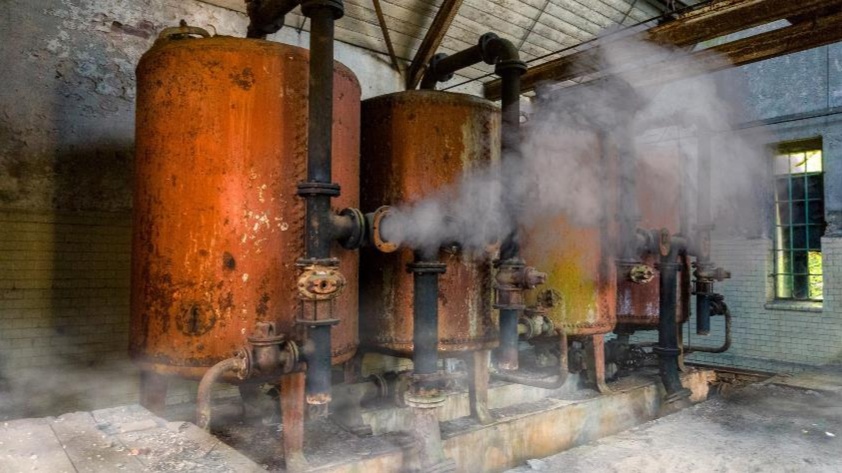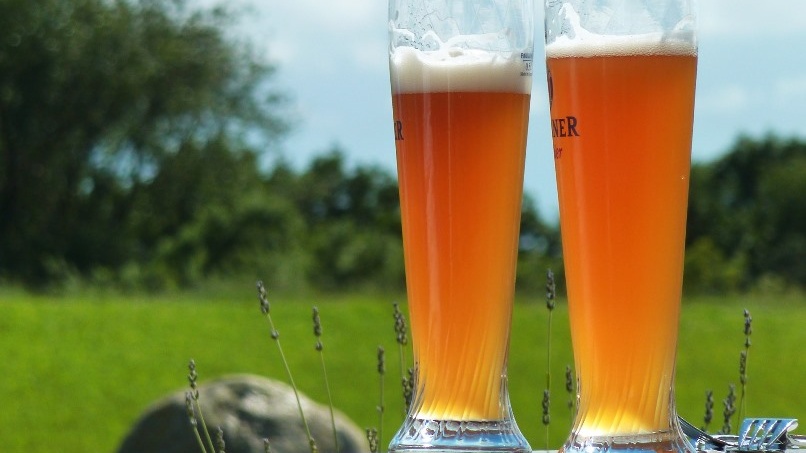In the glossary you will find terms from the fields of beverages and the beverage industry.
This is an index under construction. Here you will find explanations and definitions of terms from the world of beverages.

Our new A-Z glossary is still under construction. Here you can find explanations and definitions of terms that play a role in the areas of beverages, the beverage industry or its machines.
For everyone who is involved in this field professionally and/or privately, the question surely arises sometimes: What exactly is hidden behind this or that term? Sometimes it is a question of terms from everyday communication, where one believes to know what is hidden behind them. For example, simply the term "beverage". But what exactly is a beverage? There are so many different ones - beer and juice, milk and tea, alcoholic or alcoholfree. In other cases, one comes across a term that is not at all familiar in everyday life, but which may well be of significance in the beverage industry. In such cases, you might quickly look for a definition or explanation of the term. Or do you know what "Danzovia tonic wine" is?
With our glossary, we offer you the opportunity to search our homepage quickly and efficiently for terms that you may have come across somewhere in one of our press releases and whose exact meaning is unclear to you. Or perhaps you have a spontaneous thought and are simply wondering what exactly is hidden behind a certain term from the world of beverages.
This glossary, which is a work-in-progress, so to speak, will continue to grow over time and include more and more terms. We are pleased to provide you with another service on our homepage that can serve as a compass and orientation guide in the world of beverages.
Glossary A to Z
A
Activated carbon
Activated carbon is porous, fine-grained carbon with a large inner surface area that is used as an adsorbent in drinking water treatment, wastewater treatment and ventilation and air conditioning technology, among other applications. Activated carbon is used in granulated or pressed tablet form.
Example for a supplier of activated carbon
Additives
Additives are compounds designed to regulate the structure, taste, odor, color, and chemical and microbiological shelf life of processed foods.
Example for a supplier of additives
Alpha-Value
The alpha value is a quality characteristic of hops. It indicates how high the bittering potential of the hops is. The alpha acid content of the hops in turn serves as the basis for calculating the amount of hops added to the beer.
Altbier
Altbier is a dark top-fermented type of beer and is mainly native to the Lower Rhine region and Westphalia.
Exemple for an Altbier-Brewery
Aromas
Aromas for an optimal taste and smell experience of beverages.
Example for a supplier of aromas

BOTTLE CAPSULES
B
Barley
Barley is - along with water, hops and yeast - one of the four basic ingredients of beer.
Example for a supplier of barley
Beer colouring
Beer colouring is the food additive E150c, which is added to beer to change its color.
Example for a supplier of beer colouring
Bottle capsules
Capsule covering the cork, which is the uppermost part of a foil tightly enclosing the bottle neck. This protects the cork from drying out, contamination with bacteria, for example, and infestation by the cork moth and its egg-laying.
Example for a supplier of bottle capsules
Brew-house equipment
Mashing in, adding brewing water, boiling, cooling and pumping the wort into the fermentation tanks - the brewhouse is the heart of the brewery.
Example a for a supplier of brew-house equipment
Brewing gypsum
Brewing gypsum / calcium sulphate is used to increase the acidity of the mash (lowering the pH) and to increase the hardness of the water.
Example for a supplier of brewing gypsum
Brewing sugar
Brewing sugar provides more aroma and also a higher alcohol content.
Example for a supplier of brewing sugar
Brown ale
Simple, pure barley ales were called brown ales and were considered everyday beverages.
Example for a Brown ale brewery

BROWN ALE
C
Can turner
With the can turner, full and empty containers made of glass, plastic, metal or other materials can be turned through any required number of degrees.
Example for a supplier of can turners
CO2 Container
In so-called cold gasifiers, the carbon dioxide is stored in liquid form and taken from the cryotank in gaseous or liquid form as required.
Example for a supplier of CO2 containers
Colourants
Generic term for all colouring substances. A distinction is made between inorganic and organic colourants according to their chemical composition.
Example for a supplier of colourants
Colouring Foodstuffs
Intensely colored fruits, vegetables, and edible plants are transformed into vibrant, high-performing color solutions.
Example for a supplier of colouring foodstuffs
Crate washing machines
The machine cleans bottle crates in the immersion bath and in the spraying sector.
Example for a supplier of crate washing machines
Crown cork
A crown cork is a circular piece of sheet metal whose edge is bent into a crown shape and seals beverage bottles airtight and tasteless.
Example for a supplier of crwon corks
D
Danzovia tonic wine
Originally, Danzovia tonic wine comes from Gdansk. It is a barely beer-like drink with a syrupy consistency and dark colour, which has a very sweet taste. It used to be mixed and enjoyed with other beers or diluted with water.
Example for a Danzovia tonic wine brewery
Decappers
A decapper is a machine that removes crown caps from beverage bottles in preparation for cleaning and refilling bottles.
Example a for a supplier of decappers
Decarbonating plants
Decarbonisation has the task of removing the hydrogen carbonates of calcium and magnesium dissolved in the water, the carbonate hardness.
Example for a supplier of decarbonating plants
Dextrose
Dextrose belongs to the group of carbohydrates, is a simple sugar (monosaccharide) and is also commonly called glucose.
Example for a supplier of dextrose
Draff drying plants
Brewer's grains are a by-product of the brewing industry, accounting for 85 percent of brewing waste. Drying the spent grains leads to a preservation of the material and an associated longer shelf life.
Example for a supplier of draff drying plants
Drying kiln
In the case of grain, malt and hops, the moisture must be removed by drying in order to make the product durable.
Example for a supplier of drying kilns
Drying plate
Hurdle or plate on which the green malt is placed for drying.
Example for a supplier of drying plates
E
Enzymes
Enzymes are substances that consist of giant biological molecules and can act as catalysts to accelerate a chemical reaction; for example, they improve juice yield or reduce the carbohydrate content in beverages.
Example for a supplier of Enzymes
Evaporators
The thermal separation process of evaporation can be used to obtain a concentrate of the desired liquid from emulsions, suspensions and solutions.
Example for a supplier of evaporators
F
Flavor
Flavor is the combination of both aromatics, taste, and mouthfeel.
Example for a supplier of flavors
Fructose
Fructose is obtained industrially from vegetable starches. Fructose is increasingly used as an industrial sweetener.
Example for a supplier of fructose
Fruit extract
An extract is a substance that is extracted from a mixture of substances with the aid of a solvent such as water, alcohol or oil.
Example for a supplier of fruit extracts
Fruit press
A fruit press is actually a mash press, i.e. the fruit must first be crushed into mash for the pressing process. For fruits with firm pulp, you need a fruit mill to juice the must.
Example for a supplier of fruit presses

FRUIT PRESS
G
Gose
Gose is a type of beer that originated in Goslar (Germany) and bears some resemblance to both Berliner Weiße and Belgian lambic beers and their special form, Geuze. Nowadays, the top-fermented brewing method is used, with a bacterial lactic acid fermentation taking place in addition to the alcoholic one, which leads to the typical sour taste. Another peculiarity is the addition of common salt and coriander.
Example for a Gose-brewery
H
Hops
Hops are also known as the "soul of beer". This is because the bitterness of the hops forms the perfect counterpart to the malt sweetness and, depending on the hop variety, gives the beer its flavor profile.
Example for a supplier of hops
Hop press
A hop press presses the hops into a package of a certain bale size.
Example for a supplier of hop presses

HOPS
I
India Pale Ale
Pale, top-fermented, hop-accented Pale Ale. The beer was very durable and could therefore be supplied to the then British colony of India.
Example for an India Pale Ale brewery
J
Juice
Juice is a liquid product obtained from fruits or vegetables intended for human consumption. The fruit content must be 100 %. A distinction is made between direct juice and juice from concentrate. In the latter case, the juice is concentrated in the country of origin and re-diluted in the country of destination.
Example for a supplier of juices
K
Kölsch, Kolsch
Kölsch is a light, filtered and top-fermented full-bodied beer. It is traditionally drunk from a slim, thin-walled glass of 0.2 liters.
Example for a Kölsch brewery

JUICE MADE OF VEGETABLES
L
Lager
The production of bottom-fermented beer requires low temperatures, which is why brewing was limited to the cool winter months before the invention of the refrigeration machine. Because of its good storage properties, it could be stored in ice cellars until the following autumn. The name lager refers to this property.
Example for a Lager brewery
Level controller
A level controller regulates the automatic control of drainage pumps and overflow and dry boiling protection, automatic filling and emptying of vessels, basins, tanks, etc. The level controller is suitable for detecting conductive media (water, etc.).
Example for a supplier of level controllers
M
Malt
Malt is grain that has been briefly germinated and dried again. This process forms and activates enzymes in the grain, which are necessary for brewing beer, for example.
Example for a supplier of malt
Malting
In a malt house, malt is produced from brewing grain by malting. Breweries used to malt themselves, but nowadays only a few breweries produce malt themselves.
Example for a supplier of maltings
Malting barley
Malting barley is barley grown for brewing purposes and thus for human consumption.
Example for a supplier of malting barley
Mash coppers
During mashing, the milled malt is mixed with warm water in the mash tun. In the process, substances of the malt are dissolved in the water and brought into a soluble form by the malt's own enzymes.
Example for a supplier of mash coppers
Microbreweries
Microbreweries are breweries with only a small production volume of beer, i.e. up to 5,000 hl of beer per year.
Example for a Example for a microbrewery
Mill room
A mill room is used to grind grain into grist. In breweries, it is used to grind malt into grist.
Example for a supplier of mill rooms
N
New England IPA (NEIPA)
NEIPAs are cloudy and taste much "fruitier" and usually lighter than classic American IPAs. They are also known as "Hazy IPA" or "Milkshake Beers".
Example for a NEIPA brewery
O
Oud Bruin (Old Brown)
Oud Bruin (Old Brown), also known as Flanders Brown, is a style of beer originating from the Flemish region of Belgium. The Dutch name refers to the long aging process. It undergoes a secondary fermentation, which takes several weeks to a month, and is followed by bottle aging for several more months. The extended aging allows residual yeast and bacteria to develop a sour flavor which is characteristic for this style.
Example for an Oud Bruin brewery
P
Pasteurizing plants
In the pasteurisation unit, liquid or pasty foods are briefly heated to temperatures of at least 72 °C to kill the vegetative phase of microorganisms.
Example for a supplier of pasteurizing plants
PET preform
A PET preform is the injection-moulded preform of the PET bottle, with the PCO 28 mm closure thread already finished.
Example for a supplier of PET preforms
Pilsner
Pilsner is a bottom-fermented beer named after the city of Pilsen with an increased hop content.
Example for a Pilsner brewery
Pub brewery
A pub brewery is a microbrewery where the beer produced is served mainly or exclusively in a pub attached to the brewery.
Example for a Pub brewery
Q
Quadruple
A beer style that produces particularly complex and aromatic beers is the Quadruple / Belgian Strong Ale. A very strong Belgian ale that impresses with a mixture of malt aromas, dark / dried fruits and a subtle spiciness.
Example for a Quadruple brewery
R
Russian Imperial Stout
Russian Imperial Stout is a dark, strong stout. This beer was brewed in England in the 18th century as a gift for the Russian Tsarina Catherine the Great. Numerous smaller breweries in England and especially in the USA have rediscovered this highly aromatic beer style and are brewing it again.
Example for a Russian Imperial Stout brewery
S
Screw cap
A screw cap is used to seal containers such as tubes, plastic cans, screw jars and beverage bottles airtight. For this purpose, it is provided with a thread at the opening.
Example for a supplier of screw caps
Small brewery
A small brewery is a brewery with an annual production of up to 50,000 hl of beer.
Example for a small brewery
Starch
Sweetness, and certain nutritional qualities of soft drinks, fruit drinks, brewing and alcoholic beverages are often derived from starch products, such as glucose and fructose syrups.
Example for a supplier of starch
Steam boiler
A steam boiler is a closed heated pressure vessel or pressure pipe system that serves the purpose of producing steam or hot water.
Example for a supplier of steam boilers
Stout
Dark, top-fermented beer made from aromatic roasted malts and with a light head.
Example for a Stout brewery
Sweeteners
Sweeteners are synthetically produced or natural substitutes for sugar, e.g. from sweetener plants.
Example for a supplier of sweeteners
Syrup
Viscous concentrate obtained from sugar-containing liquids such as sugar water, sugar beet juice, fruit juices or plant extracts and used for beverages, among other things.
Example for a supplier of syrup
Syrup rooms
Flavours are developed in the syrup room that find their starting point in ready-to-drink beverages or ready-to-drink syrups.
Example for a supplier of syrup rooms


STEAM BOILER
T
Tripel
The Tripel is a typical Belgian beer style and comes from the brewing tradition of the Trappist monasteries. The name refers to the strength of the beer as the tripel is a particularly strong beer. In general, tripels taste malty and bitter, but fruity notes can also be detected. Compared to other beer styles, they have a higher alcohol content of between 7 and 11%.
Example for a Tripel brewery
U
Unfiltered beers
Unfiltered beers are naturally cloudy beers that are also clarified but not always filtered. The beers are usually bottom-fermented and have a low carbon dioxide content. The yeast in these yeast-cloudy beers has a certain inherent bitterness. Unfiltered beers taste more full-bodied.
Example for an unfiltered beers brewery
Unscrewing machine
An unscrewing machine is a device that removes screw caps from beverage bottles in preparation for cleaning and refilling bottles.
Example for a supplier of unscrewing machines
V
Viscometer
A viscometer is a physical measuring device for determining viscosity (resistance of a liquid to forced movement). Only when a product is set in motion can a statement be made about the viscosity of a liquid.
Example for a supplier of viscometers
W
Wheat beer
Top-fermented beers with a high proportion of wheat malt. Synonyms are Hefeweizen, Weizenbier, Weisse and Weissbier.
Example for a Weizenbier Brewery
Y
Yeast
When the beer wort is heated, sugar dissolves from the malt. The yeast converts this into alcohol.
Example for a supplier of yeast

WHEAT BEER






